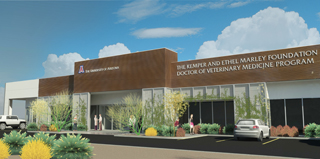
U of AZ rendering 320

Image courtesy of Arizona Board of Regents/University of Arizona
An artist’s rendering of the University of Arizona College of Veterinary Medicine depicts the program's headquarters in Oro Valley. Its main building is named for the Kemper and Ethel Marley Foundation, which gifted $9 million to UA to support the program's development in 2014.
The Council on Education has given its nod to the University of Arizona College of Veterinary Medicine, signaling an end to the program's six-year battle for accreditation.
The UA veterinary college in Tucson is on track to become the nation's 31st program, opening with 100 students in August 2020.
The COE, the only federally backed accrediting body for veterinary education and part of the American Veterinary Medical Association, voted this month to extend reasonable assurance to UA. Reasonable assurance is a first step in the accreditation process, issued only if evaluators believe a program has a feasible plan for achieving full accreditation once its inaugural class graduates. The designation provides students with access to federal loans under Title VII of the U.S. Public Health Act.
University officials shared the news on Thursday in an online media announcement, celebrating the success of their quest toward accreditation, a process that the program has struggled with since 2013.
UA's previous difficulties with the COE were not mentioned by UA President Robert C. Robbins, who stated in the news release that "This show of support from the AVMA paves the way for the University of Arizona to become a leader in veterinary medical education."
Officials originally aimed to open in fall 2015, the program's development jumpstarted by a $9 million grant from the Kemper and Ethel Marley Foundation. UA also received an $8 million appropriation from the Arizona Legislature, money slated to retrofit a 30,000-square-foot building in Oro Valley for the program's main administrative offices and pre-clinical education center.
But the promise of opening by 2015 proved to be elusive. In 2016, the COE withheld accreditation from UA based on findings that the program failed to meet four of 11 accreditation standards. UA appealed, but a hearing panel appointed by the AVMA Board of Directors sided with the COE in early 2017.
UA responded in February 2017 by hiring the consulting services of Mark Cushing, a lawyer and policy adviser who's successfully ushered veterinary medical programs at Ross University, Lincoln Memorial University and the National Autonomous University of Mexico through the accreditation process.
During the Pet Healthcare Industry Summit hosted last month by Banfield Pet Hospital, Cushing predicted that UA would be accredited within weeks.
UA's veterinary college will not include a traditional teaching hospital. Rather, it will employ a hybrid-distributive teaching model that will use UA facilities including the Campus Agriculture Center for on-site clinical training, and send students offsite for clinical training at locations ranging from urban specialty hospitals to rural mixed-animal practices.
Dr. Julie Funk, dean of the program since March, said she's anxious to get started. The goal, she said, is for students to have their hands on animals from their first week through their last.
"We have a real focus on making sure that students are learning veterinary medicine in context, looking at what they're learning in the classroom and how that relates to what they're going to do in practice," she said in the news release.
The college will be the first public veterinary school in Arizona and the state's second veterinary school. Midwestern University, a private college in Glendale — a two-hour drive north of UA — opened in 2014, seating 102 first-year students.
Charging tuition of more than $55,000 per year, Midwestern is among the most expensive veterinary programs in the country, and UA isn't far behind. Early in the program's development, UA officials promised a more affordable option for state residents, aiming to set tuition at $28,000 a year. Officials now anticipate that the Arizona Board of Regents will set tuition significantly higher: $45,000 a year for residents and $68,000 for non-residents. UA's program is designed to be completed in three years, summers included, rather than the traditional four years required by other institutions.
"Our program is structured to be completed in three calendar years, meaning you will graduate sooner and get to work one year earlier than you would in most other DVM programs," the UA website says.
The rise of both programs in Arizona reflect an era of growth for U.S. veterinary education that has not been seen since the 1970s, when seven new programs were established. The same year Midwestern opened, so did a veterinary program at Lincoln Memorial University, a private university in Harrogate, Tennessee. Now, LMU aims to double its class size of 90-some students — an expansion large enough to require COE approval.
New programs at Texas Tech University and Long Island University Post also are in the accreditation pipeline, and an upstart could be brewing. The private equity firm Global Veterinary Partners is exploring developing a veterinary program in southern Florida. If established, it would be a second veterinary school in the state. A program exists at the University of Florida in Gainesville.
Update: On Oct. 24, 2022, Lincoln Memorial University announced that it received approval from the American Veterinary Medical Association's accrediting body, the Council on Education, to add a second class of 100 students in the spring. The addition will almost double the size of the program, which opened in 2015. Officials with the university, in central Appalachia, said they proposed the expansion as a way to meet the area's need for more veterinarians.